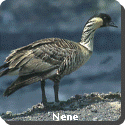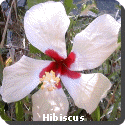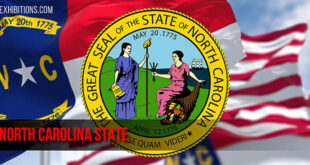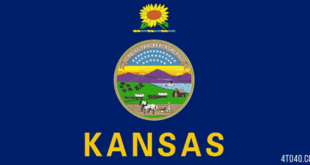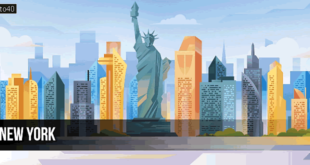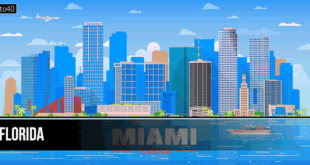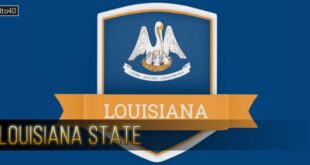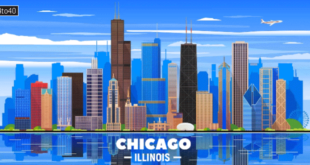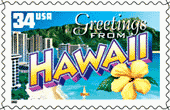 Hawaii, the most recent state to be admitted to the United States, is made up entirely of islands in the mid-Pacific Ocean. The point closest to the mainland of the United States is about 3,365 km (2,091 mi) southwest of San Francisco. A famous tourist spot, Hawaii is called the Aloha State; aloha is an expression of love or goodwill in the Hawaiian language. The state has a mixed population, consisting primarily of persons of Japanese, Filipino, Polynesian, and Chinese descent, as well as Caucasians.
Hawaii, the most recent state to be admitted to the United States, is made up entirely of islands in the mid-Pacific Ocean. The point closest to the mainland of the United States is about 3,365 km (2,091 mi) southwest of San Francisco. A famous tourist spot, Hawaii is called the Aloha State; aloha is an expression of love or goodwill in the Hawaiian language. The state has a mixed population, consisting primarily of persons of Japanese, Filipino, Polynesian, and Chinese descent, as well as Caucasians.
The first Europeans to visit the islands were probably Capt. James COOK, a British naval officer, and his crews aboard the Resolution and Discovery in 1778. In 1898 the Hawaiian Islands were annexed by the United States. American entry into World War II was precipitated by the surprise Japanese attack (Dec. 7, 1941) on U.S. military installations in and around PEARL HARBOR, an inlet near HONOLULU, Hawaii’s capital. Hawaii became the 50th state on Aug. 21, 1959.
Land & Resources
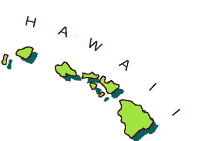 Located astride the Tropic of Cancer, the state of Hawaii includes about 130 islands spread across approximately 2,600 km (1,600 mi) in the Pacific Ocean. Only eight of the islands are sizable, and only seven are regularly inhabited. Most of the islands were created by volcanic action. The highest point is MAUNA KEA (4,205 m/13,796 ft high), an apparently extinct volcano on Hawaii Island. The approximate mean elevation of the state is 924 m (3,030 ft). The state has 1,207 km (750 mi) of coastline and 1,693 km (1,052 mi) of tidal shoreline.
Located astride the Tropic of Cancer, the state of Hawaii includes about 130 islands spread across approximately 2,600 km (1,600 mi) in the Pacific Ocean. Only eight of the islands are sizable, and only seven are regularly inhabited. Most of the islands were created by volcanic action. The highest point is MAUNA KEA (4,205 m/13,796 ft high), an apparently extinct volcano on Hawaii Island. The approximate mean elevation of the state is 924 m (3,030 ft). The state has 1,207 km (750 mi) of coastline and 1,693 km (1,052 mi) of tidal shoreline.
It is believed that the islands began to develop from a fissure in the ocean floor about 25,000,000 years ago during the Miocene period. Lava outpourings have dominated volcanic activity and have formed a chain of shield-shaped domes, eroded over time into their present shapes. Current active Hawaiian volcanoes are characterized by fissure eruptions, generally preceded by local earthquakes.
Physiographic Regions
The state may be divided into three groups of islands–coral and sand islets in the northwest, rocky islets in the center, and the eight larger islands in the southeast. The islets, about 124 altogether, have a combined area of only about 7.8 sq km (3 sq mi). The eight main islands are described below, in descending order according to size.
Hawaii (10,458 sq km/4,038 sq mi) is the largest island. It was formed by five volcanoes, two of which–KILAUEA (1,247 m/4,090 ft high) and MAUNA LOA (4,169 m/13,677 ft)–are still active. Several short rivers are on the island, mostly near the coast in the north and east; some empty into the ocean as spectacular waterfalls over rocky cliffs. Lake Waiau (0.6 ha/1.5 acres), the third-highest lake in the United States, is near the top of Mauna Kea.
MAUI (1,888 sq km/729 sq mi) is made up of two volcanic complexes joined by a low-lying isthmus. Both volcanoes are now dormant, and one of them, HALEAKALA (3,055 m/10,023 ft high), has one of the world’s largest extinct volcanic craters.
Kahoolawe (117 sq km/45 sq mi) is hilly and barren, with a maximum elevation of about 450 m (1,477 ft). The island is not regularly inhabited and is used by the U.S. military for target practice. Lanai (363 sq km/140 sq mi) is hilly and rises to 1,027 m (3,369 ft) atop a long-extinct volcano. The island is privately owned by a firm that uses the land to grow pineapples. Molokai (676 sq km/261 sq mi) is made up of three distinct regions, each formed by a separate volcano. In the east are rugged mountains, with sheer cliffs, some of which overlook the ocean. In the center is a fertile plain, and in the west is a broad, sandy plateau.
OAHU (1,575 sq km/608 sq mi), the most populated island, is made up of two rugged mountain ranges (each formerly a great volcano)–the Waianae Mountains in the west and the Koolau Range in the east–separated by a wide fertile lowland containing several steep-sided gorges. Pearl Harbor, one of the best natural harbors of the Pacific Ocean, is in the south. Diamond Head and Punchbowl, remnants of extinct volcanoes, are noted landmarks near the city of Honolulu.
Kauai (1,432 sq km/553 sq mi) receives high precipitation and has much lush vegetation. Near the center of the circle-shaped island are Kawaikini Peak (1,576 m/5,170 ft high) and Mount Waialeale (1,548 m/5,080 ft high). The island has many streams, some of which have worn deep canyons into the rock; Waimea Canyon is noted for its high walls of multicolored rock.
Privately owned, Niihau (189 sq km/73 sq mi) is made up of a central tableland (reaching about 390 m/1,280 ft) fringed by low-lying plains. The owners, descendants of Elizabeth Sinclair (who bought it in 1864), encourage the preservation of traditional Hawaiian culture and discourage outsiders from visiting the island.
Climate
Hawaii has mild temperatures throughout the year, with little difference between the hottest and coolest months and between day and night. Honolulu has a normal daily mean temperature of 22 deg C (72 deg F) in January and 27 deg C (80 deg F) in July. The equable climate is due to the effects of the northeast trade winds, which blow across the islands almost continuously during the summer.
Three times as much rain falls on the islands as on the adjacent sea. Precipitation is distributed unevenly; windward locations generally receive more rainfall than leeward areas, and higher elevations receive more than lowland regions. Mount Waialeale (on Kauai), one of the wettest places on Earth, receives about 12,192 mm (480 in) of rainfall every year. Honolulu receives about 584 mm (23 in) annually, most of it falling between November and March. Snow falls at locations generally higher than 2,740 m (9,000 ft).
Vegetation and Animal Life
The islands have a wide variety of flora, including approximately 2,500 kinds of plants not found elsewhere. More than 40% of the state is covered with forests composed primarily of tropical hardwoods and shrubs. Common trees include koa, lehua, guava, and screw pine. Almost 1,400 species of flowering plants, including orchids, hibiscus, bougainvillea, gardenias, and poinsettias, grow in Hawaii.
Because of its isolation, few land mammals have come to Hawaii through natural dispersal. A small bat and a seal were the only species of land mammals in the islands upon the arrival of the Polynesians, who brought with them the dog, pig, and commensal rat. Cats, horses, cattle, goats, and sheep, were brought to the islands by Europeans. A number of unique land birds inhabit Hawaii, such as the nene, or Hawaiian goose, and an endemic family of Hawaiian honeycreepers. Marlin, dolphin, and tuna are found offshore.
Historic Sites
Many of Hawaii’s historical sites date from the pre-European period: the Pu’uhonua o Honaunau National Historical Park, on Hawaii island, includes prehistoric house sites, royal fishponds, coconut groves, and spectacular coastal scenery; Puukohola Heiau National Historic Site, on Hawaii island, is the site of ruins of a royal temple. The U.S.S. Arizona Memorial, at Pearl Harbor, commemorates crew members of a ship sunk by the Japanese on Dec. 7, 1941.
Tourism
The tourist industry, which grew rapidly in recent decades, is the leading private segment of the Hawaiian economy. Each year the islands attract a few million visitors. Oahu is the leading destination of most tourists. The state’s pleasant climate and its fine sand beaches (especially Waikiki Beach, a part of Honolulu) are leading attractions. Also popular are Haleakala National Park, on Maui, and Hawaii Volcanoes National Park, on Hawaii, as well as numerous state parks and recreation areas.
History
Between AD 400 and 900, Polynesians from the Marquesas Islands and Tahiti settled some of the Hawaiian Islands. These people, who had traveled across the ocean in large sailing canoes, were able to make implements and structures, and they enjoyed an excellent standard of living in Hawaii. Their economy was based on ahupuaa, land units that extended from mountaintop to the sea.
In a social system similar to medieval European feudalism, there was a hereditary ruling class, called the alii nui, and below it were the common people, primarily fishermen and farmers. Religion was based on a belief in gods existing in all forces and objects; a taboo system, kapu, provided rules for maintaining the political and social order.
Europeans may have visited present-day Hawaii as early as the 16th century, but the first Europeans to sight the islands and return to tell of them was the British party of Capt. James Cook. Cook landed at modern Waimea, on Kauai, in January 1778, and he named the archipelago the Sandwich Islands, in honor of the 4th earl of Sandwich, then head of the British Admiralty. Cook was killed by Hawaiians on a return voyage in 1779, but foreigners soon began trading with the islanders.
The Kamehameha Dynasty
When Cook visited, there were about 300,000 Hawaiians, divided into several competing political units. But one ruler, KAMEHAMEHA I, gained control of Hawaii island in a ten-year war (1782-92) and by 1795 held all the main islands except Kauai and Niihau, which he added in 1810. Kamehameha’s success was largely due to the use of firearms obtained from white merchants. After 1810 white traders (many of whom were Americans) were interested primarily in Hawaiian sandalwood, most of which was shipped to China. The outside traders brought with them several infectious diseases that killed many Hawaiians, resulting in a steep population decline by the mid-1800s.
In 1819, Kamehameha I died and was succeeded by Kamehameha II, who abolished the Hawaiian religion shortly before the arrival (1820) of Protestant missionaries from New England. These missionaries had a lasting effect on Hawaii, as they introduced Christianity, Western education, and the press. Opposition to missionary-inspired laws caused considerable trouble, and when Kamehameha III (r. 1825-54) took the throne there were many foreigners who took part in an attempted overthrow of the government.
An American missionary, William Richards, became a government advisor, and with his assistance the government promulgated (1839) the Declaration of Rights and the Edict of Toleration. Not long afterward the first constitution was written. These documents introduced many Western characteristics of government, including legislative, executive, and judicial branches, and secure personal and property rights. The greatest accomplishment of this era was the Great Mahele, or division of lands, whereby modern land titles were created out of a feudal system of land ownership.
In 1842 the United States indirectly recognized the independence of Hawaii, and, during 1842-54, Gerrit P. Judd (1803-73), an American missionary, served the kingdom as prime minister. At the same time, Hawaii was becoming a major supply base for American whaling ships.
During the reigns of Kamehameha IV (1854-63) and Kamehameha V (1863-72), many Chinese, Polynesians, and Japanese immigrated to work in the sugarcane fields and in other industries. In 1875, during the reign (1874-91) of Kalakaua, Hawaii signed a treaty with the United States permitting easy access to American markets for Hawaiian sugarcane. New sugarcane plantations were established, some by Americans, and more laborers were brought from east Asia to work on them.
U.S. Annexation and Statehood
Kalakaua attempted to increase the powers of the monarchy, and, partly in reaction, his successor, Queen LILIUOKALANI, was deposed in 1893, primarily by foreign businesspersons who established a provisional government the following year, a republic of Hawaii, headed by Sanford B. DOLE, a Hawaiian-born American. U.S. business interests now controlled the affairs of the islands and sought U.S. annexation of Hawaii, which was formally accomplished on Aug. 12, 1898. Two years later, on June 14, 1900, Hawaii was constituted a U.S. territory, and Dole became the first governor. At the time, the islands had about 154,000 inhabitants. Pineapples were beginning to be a major commercial crop, and sugarcane output was growing rapidly; production of both crops was controlled by a few large concerns.
Tourism grew slowly, and the United States constructed several large military bases, notably at Pearl Harbor (1911).
The United States entered World War II after a surprise Japanese assault on Pearl Harbor and airfields on Oahu, and during much of the war the Hawaiian Islands, strategically located for the Pacific war, were governed under martial law. In the postwar period Hawaii enjoyed sustained economic growth, spurred in large part by tourism and military spending. The late 1940s and the ’50s were marked by considerable labor strife, as strikes were called by waterfront, pineapple, and sugarcane workers. After agitation for statehood dating back to the 1920s, Hawaii became the 50th state on Aug. 21, 1959. Since statehood, as tourism became the leading industry, Hawaii has grown steadily in terms of population and economy, especially land development.
Land
- Area: 28,313 sq km (10,932 sq mi); rank: 43rd.
- Capital and largest city: Honolulu (1990 census, 365,272).
- Counties: 5.
- Elevations: highest–4,205 m (13,796 ft), at Mauna Kea; lowest–sea level, at Pacific coast.
 Kids Portal For Parents India Kids Network
Kids Portal For Parents India Kids Network

